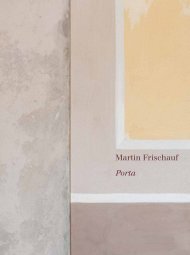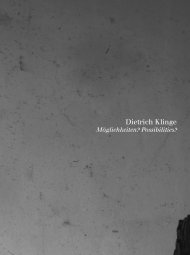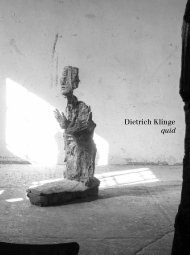Katalog_Portus_für_Jumpu
Create successful ePaper yourself
Turn your PDF publications into a flip-book with our unique Google optimized e-Paper software.
history, the technical history of sculpture flows. With a nod to the
early annals of casting since the iron age to the post-modern rigors
of carving with a chain saw, the winds of time no longer billow
but gently blow. Ironically, an allegorical framework begins to take
shape in the shaplessness wherein the importance of measureable
elements like scale and material are only just present. Only just.
In addition to the presence of Klinge’s own sculpture, several streams
of his collecting impulses converge in the space. The Egyptian, the
Etruscan, the Roman are to be found. The Eastern, the African, the
Mesoamerican, too. Most representations are frontal and calm. The
more animated visages are infrequent; a Roman dwarf scowls and
Rodin’s Man with a Broken Nose evidences the visual variety of
imperfection. The absence of any identifying labels is blissful. No
trappings of categorization, of scientific organization, of museum.
Time dissolves as intellectual and psychological intensity grows.
One begins to understand the invitation to experience something
larger and grander than oneself. The doorway of the experience is a
modest understanding that the contents of the current display of the
Portus is a thematic display about sculptures of the human figure
and the head, in particular. Crossing the foyer into the experience
allows commentary on a Contemporary sculptor inspired by the
larger history of art. Such is didactic and lacks the symbolic import
of the installation. To remain here is to remain in the prose of display
rather than explore the poetry of metaphor.
96 97
Discerning audiences have long been interested in the environments
of the artist’s home and studio. From Rembrandt’s fabled
house to Manzu’s enshrined studio, Titian’s urban palazzo to Segal’s
rural poultry barns. Great efforts have been made to capture,
even recapture such spaces: Rubens, Giacometti, Bacon. Starved for
insights to the work, desirous to consider living as a creative other,
the popularity of examining artists’ physical environments is with
us. Photography and the media have encouraged the phenomenon.
Simply consider the enthusiasm and legacy of the many photo essays
around Giacometti’s home and studio in postwar Paris or the
extraordinary popularity of Alexander Liberman’s photoessay, The
Artist in His Studio, of 1960 and his editorial efforts that brought artists
and their environments into a variety of magazine publications.
As Klinge has designed and executed the interior elements of the
Portus, there is also a certain reminiscence with Pedro Guerrero’s
At Home with Calder of 1998 which captures the artfulness of Alexander
Calder’s domestic life.
Although of parallel orbits, and in various levels of immediacy with
the respective artists, the aforementioned environments differ from
the Klinge’s intended function and future for the Portus. If anything,
the intermingling of his work and a variety of objects that deeply
affected his work is much more in sympathy with the domestic interiors
of Henry Moore’s home, Hoglands. The British sculptor left
central London in 1940 for the safety of the Hertfordshire countryside
where he lived until his death in 1986. Part of a larger complex
of studio and support buildings, and today home to the Henry Moore
Foundation, Hoglands is a deeply meaningful space for understanding
Moore and his work. Intermingled are the works of other artists
and the examples of African, Oceanic, Pre-Columbian, European
Medieval, even Cycladic, sculpture. In addition a wide array of natural
objects are intermingled: shells, bones, rocks, branches. The
informed viewer is subsumed in an art historical and natural wonderland
of stylistic and iconographic conversations with the master.
Moore’s connection to more universal carving techniques, to the
timelessness of figurative traditions, and perhaps most remarkable,
to the profound inspiration of nature and power of organic form, is
sublime. In Moore and Hoglands in Perry Green in rural Hertfordshire,
there is perhaps companionship with Klinge and the Portus in
Weidelbach in rural Bavaria. One striking difference is that wherein
places like Hoglands evolved over time and offer a summary reflection,
what Klinge has offered in the Portus, is a planned installation.
















